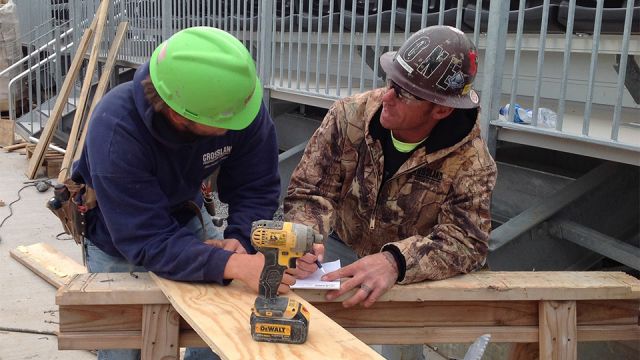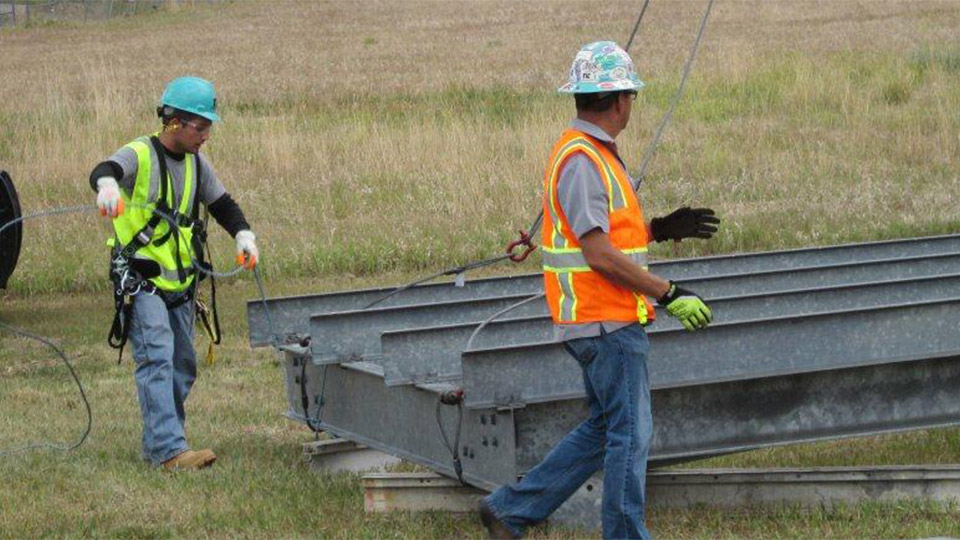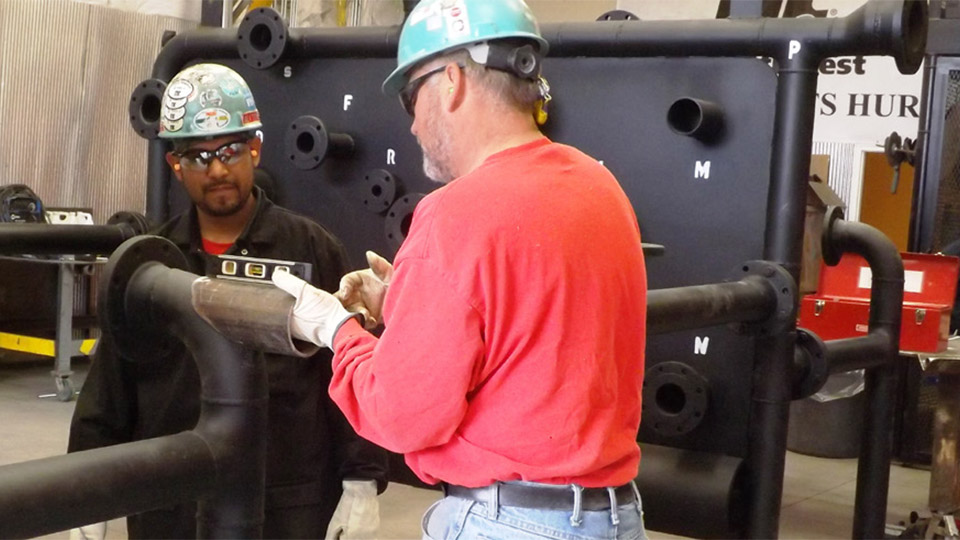It’s time for a culture change in the construction industry
The industry must elevate its commitment to its people
By Amy Saxton
Despite years of discussions about current and impending workforce shortages, industry-wide commitment to developing the construction workforce has not been obtained. The issues are far from resolved and are intensifying as other industries compete for the same limited pool of craft professionals. Now is the time for the industry to invest in workforce development and become an industry of choice. Construction needs a culture change, and to accomplish this, industry must elevate its commitment to its people.
According to the Bureau of Labor Statistics, construction is projected to have the fastest growth in both real output and employment in the entire economy from 2012 to 2022. In addition, the Construction Labor Market Analyzer (CLMA) predicts that industry will need 1.5 million more craft professionals by 2019. To compensate for the growth the American economy is experiencing as a whole, temporary employment is expected to gain momentum throughout all industries in 2015 as employers struggle to fill in-demand positions. The 2015 CareerBuilder U.S. Jobs Forecast reports that 46 percent of employers across the board are expected to hire temporary or contract workers. However, this is merely a temporary solution to a permanent problem, and the construction industry needs long term solutions. Recent articles in “The Cornerstone” and countless other publications have reported on these challenges in great detail, yet change is not occurring. The training programs, curricula and assessments needed to produce an efficient, productive and highly skilled workforce are readily available, but the critical component missing is commitment from owners and contractors to utilize these resources. Ultimately, the entire construction community needs to make the value of its people greater than or equal to the value of its projects. The industry needs to stop treating its people as a commodity and realize they are a valuable limited resource.
Owner involvement is a key element
Experience shows that improvements in craft training are possible when owners become involved and require craft training and certification. Industry’s most effective and sustainable changes are those supported and encouraged by the owner community. When owners support training on a broad scale, contractor participation will rise, and subsequently, the skills of the entire industry workforce will increase.Connie Fabre is the executive director of the Greater Baton Rouge Industry Alliance (GBRIA), a local user council that works to improve safety performance and workforce development. She recommends owners require a skilled workforce to ensure the quality of workers on their projects and increase productivity. “Many owners have not made training a requirement because they are afraid others aren’t doing it, when in fact, 98 percent of our members are requiring certification.” said Fabre. “However, this is more common on maintenance crews, not turnaround or construction work, which we still need.”
The construction industry has seen the consequences of not having a skilled workforce. When contractors struggle to meet workforce demands, they miss project deadlines, and owners are forced to extend schedules for critical projects. Contractors are also hesitant to bid on new projects knowing they lack the necessary manpower to staff them. With fewer contractors competing for work and fewer skilled professionals on projects, many owners find themselves spending more money than projected on fewer projects.
In the past, it has been difficult to identify those contractors involved in developing the skills of their people. To assist in this evaluation, the Contractors Workforce Development Assessment (CWDA) was created. This newly developed tool provides an objective evaluation of a contractor’s commitment to workforce development and the quality of their program. An A+ to F metric is used to communicate outcomes to owners and general contractors. This tool makes a contractor’s workforce development program a key criterion in both the prequalification and final selection of contractors and subcontractors.
“Research has shown that craft training pays off through improved productivity and safety and reduced absenteeism, turnover and rework,” said Don Whyte, president of NCCER. “The CWDA is a valuable tool that can help our industry recommit to workforce development. When adopted widely, it can elevate workforce development to the same status as safety, quality and schedule.”
The important role that owners play in the development of a skilled craft workforce is also evident in white papers like “The Skilled Labor Shortage Risk Mitigation,” published by the Construction Users Roundtable (CURT) in January 2015. In the paper, CURT recommends owners conduct a project risk assessment to analyze the local labor market and identify potential skilled worker shortages that might impact projects. If the analysis concludes there is a shortage, CURT identifies cost, schedule and safety as the risks that need to be considered. CURT’s white paper also addresses the need for owners to foster long-term relationships with contractors that have a proven ability to staff projects in the region and provide skills training. “Getting buy-in from all levels in a
company is always a challenge. When the leadership of a company values continuous improvement through education and training, the company keeps moving forward.” Owners should select contractors with effective and sustainable workforce strategies who can demonstrate a commitment to forecasting, recruiting, training, hiring and retaining skilled craft professionals.
“We are seeing it more and more, how important it is to owners that contractors train their employees,” said Mike Farrar, director of corporate training at Yates Construction, headquartered in Philadelphia, Mississippi. “A trained workforce builds quality projects for owners.”
Connie Fabre adds that forward-thinking owners are partnering through organizations like GBRIA, CURT and others to strengthen their impact as a community. They are finding ways to work together, whether it is funding cents-per-hour training programs or stepping up as the main drivers working with education systems to influence legislative change and increase career training.
Lastly, owners are seeing the importance of their role, along with contractors, in utilizing awareness and recruitment initiatives such as NCCER’s Build Your Future to transform the image and recruitment practices of the construction industry as a whole. All of these efforts need to reach across both owner and contractor communities. With the incredible need for skilled professionals, contractors can no longer be viewed as the group solely responsible for workforce development.
Increasing wages is not the only answer
According to a survey by the Associated General Contractors of America (AGC), 59 percent of the participating contractors report they have increased base pay rates in an effort to retain craft workers. In addition, 24 percent of those firms report providing incentives and/or bonuses for craft professionals, and 23 percent have increased benefits. In all, AGC reports that 80 percent of the contractors surveyed plan to expand their payrolls in 2015.“We are seeing wages escalate in every market we collect data in,” said Dennis Noland, owner of Alpha Resources, a human resources consulting firm that serves the industrial construction, maintenance and manufacturing industries. “We don’t see any evidence that it’s about to let up either.”
Jeff Robinson, president of PAS, Inc., a compensation consulting firm for the construction industry, adds that cross-sector craft professionals, such as heavy equipment operators and electricians, are experiencing the bulk of wage increases because they are in high demand among multiple construction sectors. Wages have increased by 4 percent over the last few years for heavy equipment operators and by 5 percent for electricians, compared to a 3-percent increase for single-sector craft professionals.
Furthermore, Noland states that per diem is becoming more common in the industry again. For example, in the greater Houston area alone, 40 percent of the projects that Alpha Resources analyzes are offering per diem at an average of $70 per day compared to one year ago when only 24 percent of the projects offered per diem at an average of $65 per day.
“The increased amount of construction happening at the same time and the competition for craft workers in multiple sectors will continue to drive wages up,” said Robinson. “It’s when all the sectors hit that you see specific areas pick up and wages start to escalate. Everyone, at all levels, is going to be impacted.”
Higher wages can only serve as a partial solution to industry’s workforce challenges. To create a sustainable pipeline of qualified professionals, training efforts will need to be elevated. However, many contractors are unwilling to give up their employees for training during regular business hours, and even though most industry executives believe there is a positive return on investment for training, they still view training as an expense that will only benefit the next contractor. According to the Construction Industry Institute (CII) research team 231, “Construction Industry Craft Training in the U.S. and Canada,” each dollar invested in craft training can yield $1.30 to $3.00 in benefits through increased productivity and reductions in turnover, absenteeism and rework.
The CII study further explains that there are numerous other factors that contribute to training resistance among the construction community, including lack of support from supervisors, lack of adequate training facilities and losing a bid due to added training costs. However, progressive contractors have improved the way they approach workforce development and are seeing amazing results.
Progressive contractors look for long term solutions
Getting Buy-In for Training Programs
Crossland Construction of Columbus, Kansas, has found great success with its apprenticeship programs and NCCER training. This is due, in large part, to the leadership team’s commitment to promote education and training among its workforce. “Getting buyin from all levels in a company is always a challenge,” said Clay Kubicek, education director at Crossland Construction. “When the leadership of a company values continuous improvement through education and training, the company keeps moving forward. When the economy slowed down, and a lot of other companies cut back on training, we increased it. We continuously improved our training during that time and made it more targeted so we could be ahead of the curve.”Training not only prepares a company for the impending uptick in work, it also lays the foundation for a company to build its ability to retain its people. Research shows that today’s employees are more likely to stay with companies that offer training programs and defined career paths resulting in upward mobility.
Yates Construction is another example of a construction company that is committed to training and advancing its workforce, despite training obstacles. “As long as we stay resilient and consistent with our message on training, this reassures workers that we will follow them and continue to train them from project to project,” said Mike Farrar. “We must stay committed to provide our workers the training they need to complete the program. By staying focused and honoring your commitment to training, workers gain confidence in the company.”
Investing in People is a Retention and Recruitment Practice
The long term vision these progressive contractors have with training is what industry needs. For many contractors, the commitment to training only comes when the need arises, regardless of the fact that it can take a minimum of three to five years to develop a trainee into a journey-level craft professional. The construction industry needs to stop looking for only short term solutions and begin looking at the big picture and the future.“It’s the price of doing business to develop a skilled workforce,” said Stacy Bell, craft talent leader at TIC, a division of Kiewit based in Colorado. “Even though we understand it can take five years to develop a craft professional, we dedicate substantial funds in operating and building our own workforce. We don’t see it as an expense; we see it as an investment.”
Investing in people is the most important investment a company can make. Training should not be an occasional focus, but an ongoing part of the company strategy to recruit, develop and retain the best people possible. Comprehensive training programs should include assessments and training prescriptions for contractors to develop a training plan for each craft professional to address the exact skills that individual needs to improve to advance in his or her career path.
“It’s really important to the new generation of workers that they have a career path,” said Mike Stilley, training and development manager at S&B Engineers and Constructors of Houston. “They are interested in knowing what kind of career path there is for them because they have a desire to move through the program.”
S&B offers multiple career paths for employees through NCCER programs. As employees satisfy the requirements of the written assessments and corresponding Performance Verifications, they become NCCER Certified Plus and begin to receive pay increases.
“We work with our employees to identify their weaknesses, develop their skill sets and pay them competitive wages for the skills they have,” said Stilley. “By doing this, we have created a sustainable workforce development plan that provides for our current employees appeals to new or prospective employees.”
Companies interested in making their recruiting and retaining practices more appealing need to begin with an internal evaluation of the career paths they offer current employees. “We work with our employees to identify their weaknesses, develop their skill sets and pay them competitive wages for the skills they have. By doing this, we have created a sustainable workforce development plan that provides for our current employees and appeals to new or prospective employees.” This is a topic that “The Cornerstone” magazine has previously promoted, and we are beginning to see more and more contractors, like the ones included here, implement this practice.
“We analyzed our compensation package and increased it for the highest credentialed workers,” said Bell. “Performance is tied to credentials, so our top-paid employees have credentials. Our employees who have been with us for three years and have worked at least 1,000 hours each year also get paid more, and they get a travel allowance. This is a retention practice for us.”
Another retention practice, which is documented in NCCER’s white paper, “Craft Workforce Development 2013 and Beyond,” is to establish mentorship programs where experienced craft professionals are utilized to mentor younger or less experienced workers. New employees typically require training and benefit greatly from mentorship by someone from the company who is skilled in the same craft. The other great advantage for the contractor is that by giving experienced craft professionals the opportunity to mentor younger workers, they can help grow the next generation of craft professionals within the company and feel a sense of true investment in the future of the organization.
Crossland Construction’s 20/20 mentorship program is designed to offer high school graduates the opportunity to receive additional NCCER credentials, become registered apprentices in carpentry or ironworking, receive a work-readiness certificate, become OSHA-10 certified and have an assigned journey-level carpenter to mentor them for three years. “It is an individual support system,” said Kubicek. “Typically, when starting a new job, you go out, and either it works out or it doesn’t. We can’t just leave it to chance anymore.”
The average employee today stays at his or her job for 4.4 years, according to the most recent available data from the Bureau of Labor Statistics, but the expected tenure of the workforce’s youngest employees is about half that. With this in mind, training and mentoring programs are cost-effective solutions to recruit and retain young craft professionals. KBR, out of Houston, experiences more turnovers among welders who were hired from outside their company as compared to those who were trained internally by KBR. Currently, the company has been able to retain more than 90 percent of the welders from its training program.
CTE Must Become Part of Industry’s Commitment to the Future
AGC’s Worker Shortage Survey Analysis states that one reason for the growing workforce shortage is that many contractors feel their local pipeline of new workers is insufficient. For example, 55 percent of firms surveyed rate the overall quality of the local pipeline for new craft workers as poor or below average. One solution to this dilemma is for industry to do better at connecting with local schools and youth organizations. NCCER provides numerous resources to help facilitate these partnerships through its Construction Career Pathways initiative. The initiative offers case studies, a career pathways map and a connection map to drive collaboration between contractors and educators. The connection map allows industry members and educators to list their contact information and areas in which they are interested in providing help or looking for help. Everything from classroom presentations to receiving guidance using curriculum more effectively are included on the map.Industry and education collaboration is gaining popularity, according to a recent AGC survey, which reports that 60 percent of construction companies surveyed are currently working with or intend to work with community colleges. Contractors and owners must substantially elevate their commitment to workforce development to include supporting and driving the resurgence of career and technical education (CTE) to meet industry standards. Industry support in promoting CTE in high schools and community colleges throughout the nation is a key component in training future craft professionals. When done effectively, the partnership can provide a local, robust talent pipeline into the industry.
Contractors like S&B, Crossland Construction, KBR, Yates and TIC actively partner with local schools and organizations to develop industry’s future workforce. Whether it is providing tools and materials, attending career fairs, presenting in classrooms or hosting field trips to project sites, they make the commitment because they know the end result will benefit their companies.
“We like to recruit from high schools, technical schools and outreach organizations that use NCCER curricula so we have a head start,” said Bell. “We have a group of preferred schools that we use as a pipeline for our company, and we help those students transition from their program into our workforce. It’s a lot of travel and a large investment for us, but it creates a better pipeline.”
Yates Construction travels throughout the southeast to recruit young craft workers from programs that use NCCER training and provide NCCER credentials because it not only fits their needs, but the needs of the industry. “We are real aggressive with recruiting because it’s our future,” said Farrar. “We are looking for the top gun students from these programs. They are out there; you just need to find them. There are a lot of great people who want to work in our industry.”
With approximately 20,000 students graduating each year from the Architecture and Construction Career Cluster in SkillsUSA, and over 3,500 high school and postsecondary schools using NCCER programs across the U.S., there are vast opportunities for industry to develop relationships with CTE programs that can become viable pipelines to their organizations. Education partnerships not only help build technical, academic and employability skills through classroom and on-the-job training, but they also offer options to students that they never knew they had.
“I see it out there,” said Stilley. “There are diamonds in the rough; you just need to find them. They want to work, and it may take time to get them skilled, but you need to start. If they have the desire and the want-to, then they can be successful.”
Unified commitment from the industry leads to opportunity
FMI’s 2015 “Craft Labor Recruiting and Retention Survey” reports that one of the most effective methods for attracting and retaining craft professionals includes being an employer of choice. An employer of choice is more than being the employer that offers the highest wages and benefits. “An employer of choice is more than being the employer that offers the highest wages and benefits. Ultimately, the employer of choice seeks to improve organizational culture and creates an enjoyable, productive place for employees to work.” Ultimately, the employer of choice seeks to improve organizational culture and creates an enjoyable, productive place for employees to work. Recognizing the human element of a company’s workforce is part of creating a positive culture.“At S&B, we make it a point to humanize our workforce,” said Stilley. “We go the extra step to get to know our employees and their families. We post pictures of our employees’ families in our lunch rooms on project sites. We are a family, and it’s a family we work with. Our employees understand that they mean something to this company, and that it’s not just a job.”
Research from the U.S. Chamber of Commerce Foundation shows that leading contractors understand that in order to remain competitive in today’s economy, they must approach talent recruitment and development like a business investment. If employers define their role as that of the end-customer, then they can develop solutions to the skills gap. Industry has the responsibility to work with schools and help focus and guide curricula and training to meet their needs. Now is the time for contractors and owners to take leadership in improving the system for recruiting, developing and employing craft professionals. When this process is viewed as a business strategy, then it becomes a permanent practice of developing the talent pipeline.
With bold leadership and transformational change, the industry’s overall skill level can significantly improve. By applying the resources readily available to develop the workforce, owners and contractors will find growth and success in today’s competitive construction market.
As an industry of pride and leadership, owners and contractors can make a historical change by utilizing available resources to develop the most productive, efficient and sustainable workforce in the world, but it all starts with a commitment to developing its people.
About the Author
Amy Saxton is the Communications Manager at NCCER.
This article was originally published in the Spring/Summer 2015 edition of NCCER’s The Cornerstone magazine (http://www.nccercornerstone.org/publications/publications-archive). This content has been republished with the permission of NCCER and the publisher.






















